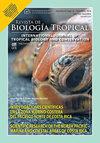Morpho-anatomy of in vitro germination and cryopreservation of the orchid Cattleya crispa (Orchidaceae)
IF 0.6
4区 生物学
Q4 BIOLOGY
引用次数: 0
Abstract
Introduction: Cattleya crispa is an ornamental epiphytic orchid with geographic distribution restricted to the Brazilian Atlantic Forest. Due to predatory extractivism and human-induced habitat loss, this species appears on the Red List of Brazilian Flora. Objective: To characterize morpho-anatomical aspects regarding germination and post-seminal development from C. crispa seeds; as well as studying the effect of cryopreservation on these seeds. Methods: We used light microscopy and electron microscopy to describe the microstructure of a 100 ripe seeds. We evaluated seed viability, seed germination, survival rate and protocorm weight in cryopreserved and non-cryopreserved material, with four replicas per treatment using 20 mg of plant material. Results: The seeds are fusiform, whitish yellow with a length from 700 to 900 µm and a water content of 5 %. Germination began seven days after sowing, the formation of the globular protocorm at 30 days and the formation of the seedling occurred 150 days. The persistent seed coat can compress the protocorm and cause it to collapse. The cryopreserved seeds presented 87.15 % viability, 78.32 % germination, 8.48 % survival and protocorms with 104.27 mg five months after sowing. Data wasn’t different to non-cryopreserved seeds. Conclusions: The cryocapability of the seeds shows that cryopreservation can be used for long-term conservation. The results of this work contribute to the overall biology of C. crispa and to the propagation and storage of genetic material for conservation purposes. Objective: To characterize morpho-anatomical aspects regarding germination and initial development from C. crispa seeds; as well as studying the effect of cryopreservation on these seeds. Methods: Mature capsules of C. crispa were collected from the ex-situ conservation collection of the Orquidário Frederico Carlos Hoehne - Institute of Botany (São Paulo-Brazil). We used light microscopy, scanning electron microscopy and transmission electron microscopy. Seed viability (%), seed germination (%), survival rate (%) and protocorms weight (mg) were evaluated. Results: Our analyses showed that the globular embryo has a homogeneously early germination that occurs by the 7th day. The germinating protocorm shows bipolarity, with shoot apex and basal region. The embryo is composed mostly of lipid and protein bodies and contains a few small grains of starch. Scanning electron microscopy images revealed a persistent seed coat that does not influence the onset of germination, however, can compress the protocorm and lead to its collapse. The initial water content of the seeds was 5 %. Seeds submitted to cryopreservation resulted in a high germination rate (81.14 %). However, the survival rate of non-cryopreserved (8.48 %) and cryopreserved (11.12 %) protocorms, evaluated five months after sowing, was reduced. Conclusions: The cryocapability of the seeds shows that cryopreservation can be used for long-term conservation. The results of this work contribute to the overall biology of C. crispa and to the propagation and storage of genetic material for conservation purposes.兰花(兰科)离体萌发和低温保存的形态解剖
简介:卡特兰是一种观赏附生兰花,地理分布局限于巴西大西洋森林。由于掠夺性采掘和人类引起的栖息地丧失,该物种出现在巴西植物红色名录上。目的:研究crispa种子萌发和种子后发育的形态解剖学特征;并研究了低温保存对这些种子的影响。方法:采用光镜和电镜对100粒成熟种子的显微结构进行了描述。我们评估了低温保存和非低温保存材料中的种子活力、种子萌发、存活率和原球茎重量,每次处理4个副本,使用20mg植物材料。结果:种子呈纺锤状,淡白色,长700 ~ 900µm,含水量5%。播种后第7天萌发,第30天形成球状原球茎,第150天形成幼苗。持久的种皮可以压缩原球茎并使其塌陷。104.27 mg冷冻后5个月种子存活率为87.15%,发芽率为78.32%,成活率为8.48%。数据与非冷冻保存的种子没有差异。结论:种子的低温性能表明冷冻保存可用于长期保存。本工作的结果有助于crispa的整体生物学和遗传物质的繁殖和保存目的。目的:研究crispa种子萌发和初期发育的形态解剖学特征;并研究了低温保存对这些种子的影响。方法:从Orquidário Frederico Carlos Hoehne植物研究所(s o Paulo-Brazil)的迁地保护馆藏中收集crispa成熟荚膜。我们使用了光学显微镜、扫描电子显微镜和透射电子显微镜。测定种子活力(%)、种子发芽率(%)、成活率(%)和原球茎重量(mg)。结果:我们的分析表明,球形胚在第7天具有均匀的早期萌发。萌发的原球茎呈双极性,有茎尖和基部。胚胎主要由脂质和蛋白质体组成,并含有少量淀粉粒。扫描电镜图像显示,持久的种皮不影响萌发的开始,但可以压缩原球茎并导致其塌陷。种子初始含水量为5%。低温保存的种子发芽率高(81.14%)。然而,播种5个月后,非冷冻保存的原球茎(8.48%)和冷冻保存的原球茎(11.12%)的存活率均有所降低。结论:种子的低温性能表明冷冻保存可用于长期保存。本工作的结果有助于crispa的整体生物学和遗传物质的繁殖和保存目的。
本文章由计算机程序翻译,如有差异,请以英文原文为准。
求助全文
约1分钟内获得全文
求助全文
来源期刊

Revista De Biologia Tropical
生物-生物学
CiteScore
1.80
自引率
0.00%
发文量
23
审稿时长
4-8 weeks
期刊介绍:
The Revista de Biología Tropical / International Journal of Tropical Biology and Conservation is a mainstream scientific journal published since 1953 and covered by Web of Science; Science Citation Index; Current Contents; Google Scholar; Scopus, SciELO and nearly 50 additional indices.
A double blind system guarantees you a fair evaluation, and our world class editorial and scientific boards provides a first decision in three working days. The journal is Full Open Access and is widely read where your article can have the highest real impact.
Since its beginning in 1953, the Revista follows these principles: objective and independent evaluation of all manuscripts; transparency in all processes; ethical use of procedures, data, specimens and subjects; fair treatment of all parties; and absolute predominance of scientific rigor over any other aspect.
 求助内容:
求助内容: 应助结果提醒方式:
应助结果提醒方式:


